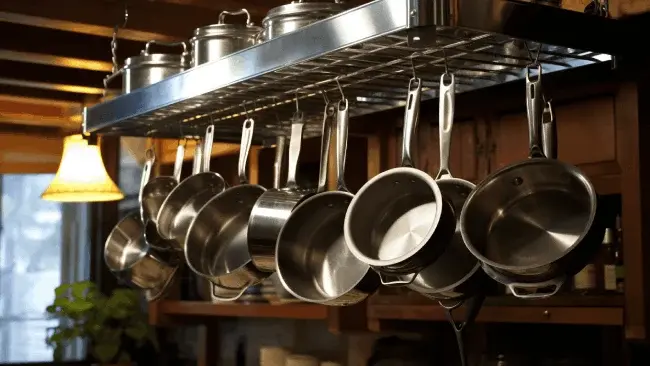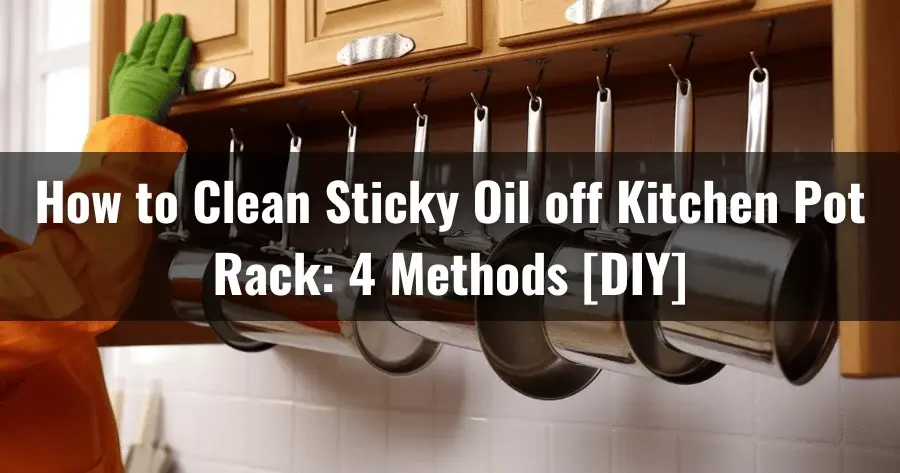Kitchen pot racks, as decorative and functional elements, are often prone to sticky oil buildup from cooking splatters. Eventually, this buildup can damage the rack and make cleaning difficult. Now you might need to know how to clean sticky oil from the kitchen pot rack to keep its utensils fresh.
You can create a dish soap and water solution, which can easily cut through the grease. Just apply the solution with a sponge and scrub away.
Alternatively, you can make a paste using baking soda paste or vinegar solution. Apply this paste, spray the solution to your pot rack, and gently scrub off the residue. You can also try using commercial cleaners for greasy messes if needed.
Here, we will discuss four simple and effective methods to clean that stubborn grease off your pot rack.
Jump to Section
How Do You Clean Sticky Oil off Your Kitchen Pot Rack?

If you struggle to clean sticky oil off your kitchen pot rack, you can try several effective methods. Our research for this guide focused only on the safest cleaning solutions and methods. Here are the four methods you can choose from:
- Method 1: Dish Soap and Water Solution
- Method 2: Baking Soda Paste
- Method 3: Vinegar Solution
- Method 4: Commercial Degreaser
Let’s take a look at each of these methods in more detail.
Method 1: Dish Soap and Water Solution
To clean sticky oil off a kitchen pot rack through this method, remove any pots, pans, or utensils from the rack to provide clear access. Once you have a clear workspace, fill a basin or sink with warm water, then add a few drops of dishwashing soap. We suggest mixing it until you have a soapy solution.
Now, submerge a sponge or clean soft garment into the soapy water. Use this to gently scrub away the sticky oil spots on the pot rack. Be thorough and reach all surfaces, including corners and crevices where oil might have accumulated.
Wash the rack thoroughly after scrubbing with a sponge or cloth. Finally, dry the pot rack with a clean cloth to prevent water spots.
Method 2: Baking Soda Paste
Make a thick paste of baking soda and water, then apply it to the sticky spots on your pot rack. We recommend letting the paste sit for 15 to 20 minutes, allowing it to break down the sticky oil residue.
Then, use a soft-bristle brush or cloth to scrub off the paste and remove the oil gently. We advise avoiding using abrasive materials that could scratch your pot rack’s surface. After scrubbing, rinse the area with clean water and dry it with a cloth.
With baking soda, it acts as a natural abrasive and helps break down and remove the sticky oil residue effectively. This method is simple, affordable, and easy at home without special tools or chemicals.
Method 3: Vinegar Solution
Spray the vinegar solution onto the affected areas of your pot rack to effectively remove any stubborn residue. Mix equal parts of white vinegar and water in a spray bottle, ensuring they are well combined.
The acidic nature of vinegar helps to break down the greasy residue on your pot rack. According to expert advice, allow the solution to sit for about 10 to 15 minutes, giving it time to work its magic.
Afterward, gently scrub the area using a soft cloth or sponge, removing any remaining oil spots. Rinse the area with water and wipe it dry with a clean cloth.
Method 4: Commercial Degreaser
If the residue is particularly stubborn, consider using a commercial degreaser to remove it effectively. Commercial degreasers are designed specifically to break down and dissolve tough grease and oil.
To use a commercial degreaser, simply apply it to the affected areas according to the instructions on the product label. Let it sit for the specified time, and then wipe or scrub away the residue. Wearing gloves and working in a well-ventilated area when using these products is important.
How Do You Prevent Sticky Oil Buildup on Your Kitchen Pot Rack?

You can follow several key tips to avoid sticky oil buildup on your kitchen pot rack. Here are they:
- Tips 01: Regular Cleaning Routine
- Tips 02: Cover Food While Cooking
- Tips 03: Cook at Lower Temperatures
- Tips 04: Use Cooking Methods with Less Splatter
- Tips 05: Properly Store Oily Cookware
Taking a closer look at each of these tips will help you achieve your desired results.
Tips 01: Regular Cleaning Routine
Establishing a regular cleaning routine for your pot rack is important. Wiping it down after cooking can prevent stubborn and sticky buildup over time. Taking just a few minutes to remove any splatters of oil or food residue with a clean cloth or sponge can make all the difference.
You should address these splatters as soon as possible before they dry and harden. Doing this simple task consistently prevents the buildup from becoming difficult to remove later on.
Regular cleaning will keep your pot rack looking clean and tidy and ensure that your pots and pans are stored in a sanitary environment.
Tips 02: Cover Food While Cooking
Using lids or splatter screens to cover your pots and pans when cooking on the stovetop is recommended. This will help prevent oils and greases from splattering onto your cookware. It’s about keeping your pots and pans clean and maintaining the cleanliness of your kitchen pot rack.
Covering your food while cooking can reduce the amount of oil sprayed around. This means less sticky residue on your pot rack. It makes cleaning up a whole lot easier.
Tips 03: Cook at Lower Temperatures
Cooking food at excessively high temperatures can release more oil splatters and residue, which can end up on your kitchen pot rack.
Adjusting the heat and cooking at lower temperatures can minimize the oil reaching your pot rack. Lower-temperature cooking allows for a slower and more controlled release of oil, resulting in less mess and easier maintenance. This helps keep your pot rack cleaner and reduces the need for frequent cleaning.
Tips 04: Use Cooking Methods with Less Splatter
Cooking methods like baking, roasting, or steaming can help minimize airborne residue and keep your kitchen pot rack cleaner. These methods generate less splatter than sauteing or frying, reducing the amount of oily residue on your pot rack.
When you choose to bake, roast, or steam your food, there is less chance of oil splattering and sticking to the surface of your pot rack. If you need to saute or fry, a splatter guard can help contain the mess and prevent oil from spreading onto your pot rack.
Tips 05: Properly Store Oily Cookware
After cooking, we advise you to avoid placing greasy pots and pans directly on the pot rack. Instead, take a moment to allow them to cool slightly before wiping off any excess oil with a paper towel. This simple step will prevent the excess oil from dripping onto the rack and creating a sticky buildup over time.
FAQ’s: How to Clean Sticky Oil off Kitchen Pot Rack
Our extensive research revealed that most homeowners have questions about caring for their pot racks. Here are the answers to the most commonly asked questions:
1. Can I clean my kitchen pot rack in the dishwasher?
Some pot racks may be dishwasher-safe, while others may need help to hold up well under the high heat and forceful water pressure of a dishwasher cycle.
Even if a pot rack is labeled as dishwasher-safe, it’s still recommended to hand wash it with gentle cleaning methods to help maintain the integrity of the rack. Hand washing allows you to give special attention to any nooks and crannies where food residue may have accumulated.
2. Is there a specific type of pot rack that’s easier to clean and maintain?

Regarding pot racks, experts say simpler designs with fewer intricate details are typically easier to clean and maintain. This is because open wire racks or racks with minimal decorative elements are less likely to accumulate sticky oil residue than those with more ornate designs.
Not only does this make cleaning a simpler process, but it also reduces the likelihood of bacteria or other contaminants building up over time. Simplicity makes pot racks more durable and long-lasting since fewer fragile or delicate elements might break over time.
Conclusion
Maintaining a clean and well-maintained kitchen pot rack will make your kitchen aesthetically pleasing and more hygienic. According to our previous discussion, you can easily remove stubborn residue with a mixture of warm water, dish soap, and vinegar.
Use non-stick cooking sprays and wipe down pots before placing them on the rack to help minimize future stickiness.
You can prolong the life and utility of your cherished kitchen equipment by paying regular attention, caring for it, and being committed to cleanliness. A shiny and oil-free pot rack enhances the aesthetics and ensures a hassle-free cooking experience.



